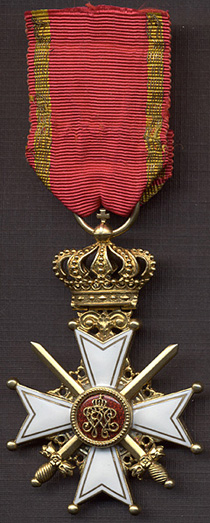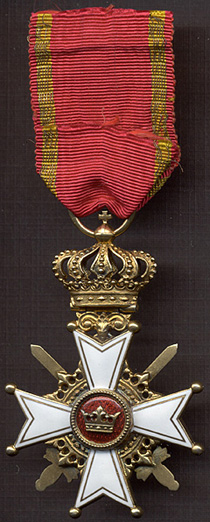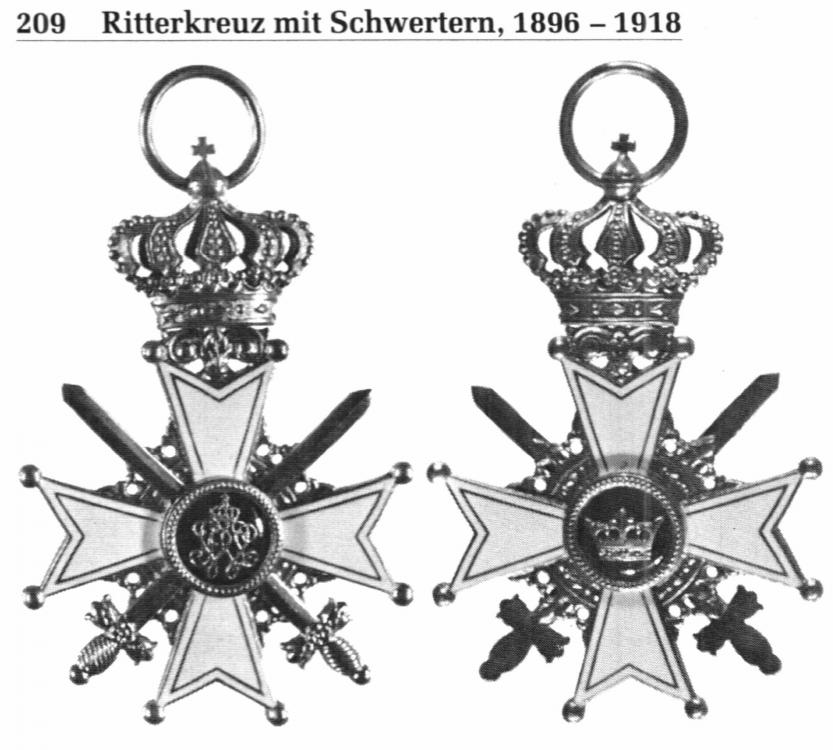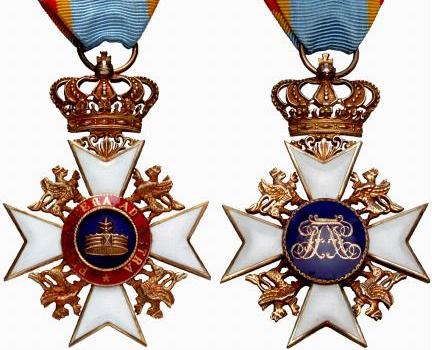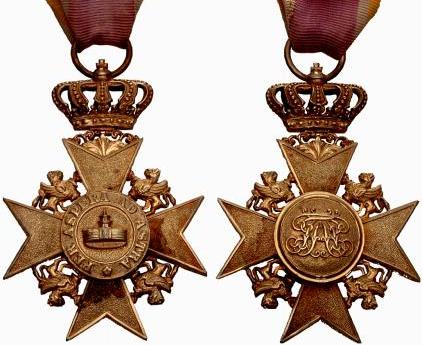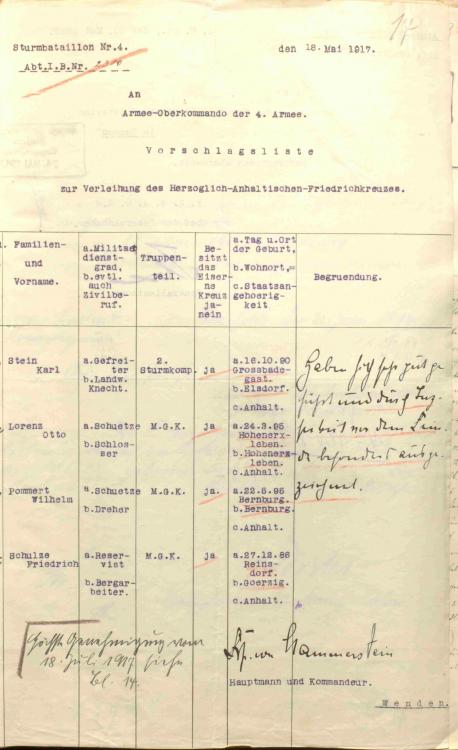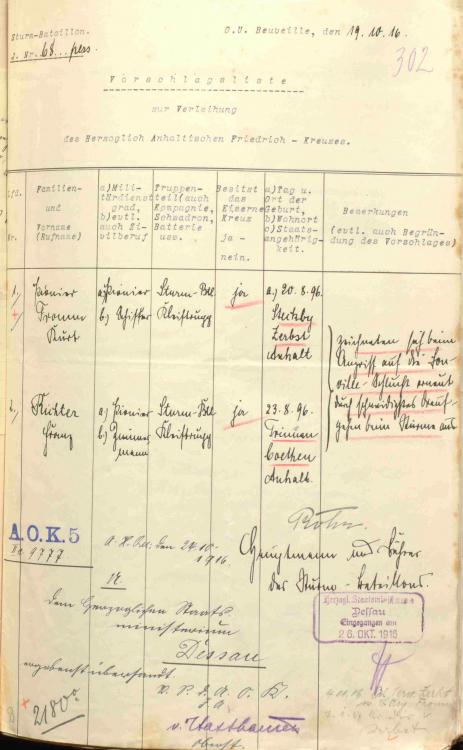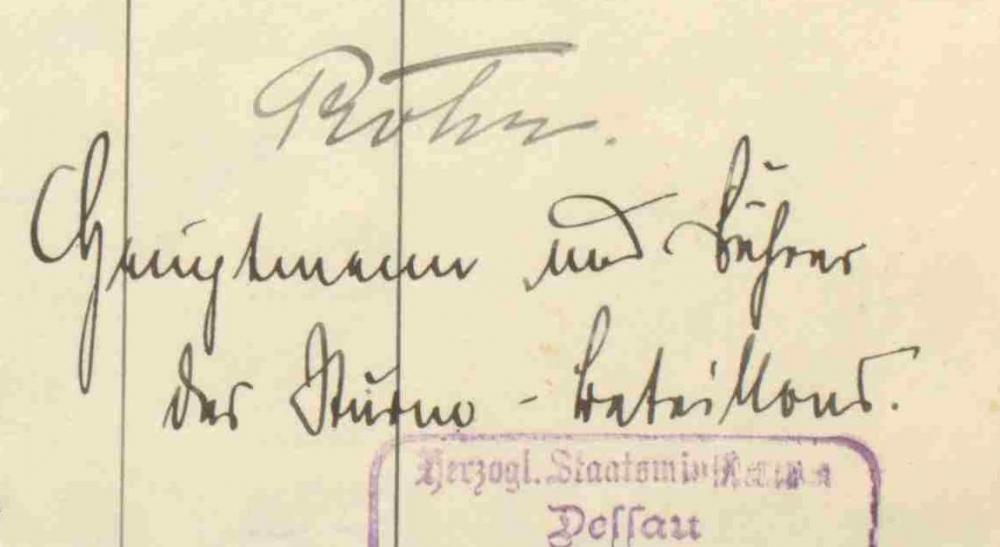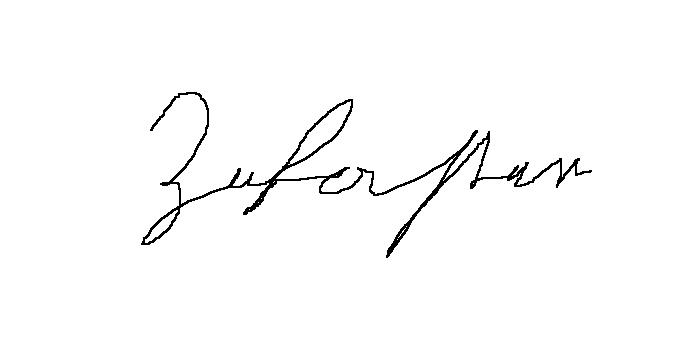-
Posts
4,908 -
Joined
-
Last visited
-
Days Won
97
Content Type
Profiles
Forums
Blogs
Gallery
Events
Store
Everything posted by Dave Danner
-
The Karl-Friedrich ribbon would be yellow-red-yellow, with thin white edge stripes. But in black&white photos, some colors show up almost the same, making the stripes hard to distinguish. Yellow often looks much darker. The red edge stripes on the green ribbon of the Anhalt Friedrich Cross also end up looking the same. The yellow stripes on the Braunschweig Kriegsverdienstkreuz may appear as dark as the dark blue of the rest of the ribbon, although that one shows up as really dark compared to your photo.
-
The 43. Reserve-Division and its subordinate units, including RFAR 43, was raised from the Prussian Guards. So he could be from anywhere in Germany (outside of Bavaria, Saxony or Württemberg) where the Guards could raise troops. Whatever the ribbon is, he ranked it higher than the Iron Cross, since he wore it both as a buttonhole and ahead of the EK2 on his ribbon bar. I am at a loss, since there were few decorations ranking ahead of the EK. The Prussian Military Merit Cross did, but it had the same ribbon as the EK. A Bavarian, Saxon or Württemberger could place their own awards first, but as he's in a Prussian regiment, the only one that comes to mind is the Baden Karl Friedrich Military Merit Medal. Or he could have been particularly proud of his own home state (Anhalt for example) and placed its award ahead of the EK. Or he's an idiot and he placed a blue long-service ribbon ahed of the EK and on the buttonhole. Or I am having a brain-fart and forgetting another appropriate decoration.
-
I don't have anything to add on the Ficks. As for Meyer-Becherer: Helmuth Friedrich Karl, *17.4.1892 in Arnstadt, Schwarzburg-Sondershausen. Sohn des am 21.8.1920 in Hannover verst. Geh.Baurats Emil Meyer und der am 29.8.1934 in Hannover verst. Elisabeth Meyer geb. Becherer. 18.3.11 aus d. Hauptkadettenanstalt als Fähnrich d. FAR 50 überwiesen, 22.5.12 Lt. (Pat. 1.6.10), 18.10.14 z. FEA 1 versetzt, 20.11.14 verwundet (Granatsplitter im Genick), 23.12.14 z. Armee-Flugpark 4, 3.1.15 als Beobachter z. FFA 40 versetzt, 8.12.15 OLt., 4.1.16 z. FEA 6 z. Ausb. als Flugzeugführer versetzt, 18.2.16 z. FEA 5 versetzt, 14.5.16 z. FFA 6 als Flugzeugführer versetzt, 7.8.16 Offz.z.b.V. bei AFP 4, 16.12.16 abgestürzt, 8.2.17 als 1.Offz.z.b.V. (Adj.) z. AFP 11 versetzt, 17.10.17 als Adj. z. Idflieg versetzt, 20.11.17 als Adj. z. FEA 9 versetzt, 22.4.18 als Adj. z. Gruppenführer d. Fl. 22 versetzt, 1.10.18 als Gen.St.Anwärter z. 111.Inf.Div. versetzt, 28.12.18 als Bttr.Fhr. z. 3.GFAR versetzt, 1.10.19 als Bttr.Fhr. z. RwAR 3 versetzt, 1.1.21 als Bttr.Offz. im 3.AR übernommen, 1.1.22 Hptm., 31.12.27 ausgeschieden. 1.10.33 als Hptm.a.D. beim Bezirkskommando Magdeburg II in das L-Offizierkorps übernommen (RDA 1.10.22), 1.5.34 z. Bezirkskommando Magdeburg I versetzt, 1.10.34 Maj.a.D., 5.3.35 Maj.(E), 1.4.35 RDA v. 1.9.33 erhalten, 6.10.36 z. Wehrersatz-Insp. Magdeburg versetzt, 1.7.37 z. d. Offz.z.Verf. d. Ob.d.H. (Standort Magdeburg) unter wirtschaftl. Zuteilung d. WEI Magdeburg versetzt, 20.11.37 z. 3 Monate Gefängnis verurteilt und mit d. 20.11.37 aus dem aktiven Wehrdienst entlassen. No further entries in his file after this date.
-
"Kämpfe bei Louvement and ? " is "Kämpfe bei Louvemont und Bezonvaux". The shooting range north of the Fort de Douaumont runs between these two destroyed villages. "prot." is actually correctly written, if a bit sloppy. Compare the "g" in "wegen", for example. A minor peeve of mine. This is not Sütterlinschrift, but rather the earlier script known simply as German cursive (Deutsche Kurrentschrift). Sütterlin was only hired in 1911 to revise the script and his system began to be introduced in 1915 and did not become widespread until well after the war. For the most part, adult Germans during the war continued to use the writing systems they grew up with. Also, these Kriegsstammrollen were written by Bavarians, and Sütterlin was hired by the Prussian education ministry. Herr Sütterlin does not deserve the credit for many a German schoolteacher's effort to make it hard for us to read old documents.
-
These are Robert Treite and his wife Luise Treite, maiden name Thans (or Thäns). According to the death certificate for their daughter, Luise Grace Katharina Treite, who died at age 2 in 1892, the ones you are looking for are apparently Carl August Adolf Treite, officer of the Salvation Army, living in Berlin, earlier in Kiatschou, and Luise Treite, born Foot.
-
For the most part, all award recommendations had to follow this procedure. Even Prinz Aribert, as a commander in the field, had to have his recommendations sent back to Dessau. Once he became Prinzregent in September 1918, though, he made a number of awards on his own authority. Duke Friedrich made a bunch of immediate awards when he visited the front, but his Flügeladjutant had to scramble to get the correct information so everything could be properly documented. For the battalion, I would assume it was the adjutant or whoever was in charge of maintaining the Kriegsrangliste/Kriegsstammrolle.
-
Here is another recommendation list, from Sturm-Bataillon 4, though with a more generic Begründung. I don't know which Freiherr v. Hammerstein signed it. Sturm-Btl. 4 was a Garde unit, so maybe Hptm.d.R. Adolf Frhr. v. Hammerstein-Loxten from the Reserve of the Garde-Jäger-Bataillon, although he might have been a Maj.d.R. by 1917. You can also see by the penciled-in notation "Höchste Genehmigung vom 18. Juli 1917" that it took two months from recommendation to approval. I am not sure how typical this is, but it usually took longer than it would for an Iron Cross, since once the recommendation was received, the Staatsministerium would then have to contact the local magistrate to confirm the citizenship and residency of the proposed awardee.
-
Steckby, where Kurt Fromm was born, was a small village on the Elbe. He was a Schiffer, or boatman, which seems to be a pretty common civilian occupation for Pionier troops, especially from Anhalt. Maybe not the most useful preparation for a flamethrower troop, but how many civilian jobs are? Franz Richter was a Zimmermann, or carpenter, which I suppose is a useful set of skills for many military jobs. Just from a quick look through the Anhalt rolls, it seems that about 2/3rds of them ended up in Pionier units. His hometown, Trinum, is a small village between Bernburg and Köthen. It used to be on the main road between the two cities, but a new highway bypasses the town and takes the B6 to the south side of Köthen near the old Soviet air force base. I've been through there about a half dozen times, but I can't say that there is a whole lot to see there, except when they have air shows. So far, I have only come across about 15 awards of the Friedrichkreuz to Sturm-Bataillon members, out of about 10,000 awards I have typed up. These are the only ones to SB Rohr, and the rest are spread out all over. No Anhalt-based unit was the replacement formation for a Sturm-Bataillon; nor apparently was PB 4, which was the parent unit for Pionier formations in the IV. corps area where Anhalt located.
-
-
Dr.phil. Heinrich Georg Conrad Karl Hawickhorst was born on 4 December 1875 in Oldenburg i. Ghzgtm. He graduated from the Oberrealschule in Oldenburg in 1896, and then was a Kand. d. höheren Lehramts in Prussian Saxony. He was promoted to Dr.phil. on 18 May 1901 by the University of Halle. From 1.10.05-30.9.12, he was an Oberlehrer in Halle (Oberrealschule Franke-Stiftung), on 1.10.12 he was named Direktor of the Realschule Ems, and on 1.12.24 he was a Studiendirektor at a Realgymnasium in Staßfurt. He retired on 1 April 1938. He was married on 5.10.07 and had four children. He was an Einjährig-Freiwilliger in Metz from 1.10.03-30.9.04, Lt.d.R. on 16.2.07 and OLt.d.R. on 8.2.15. He received the Friedrich August Cross 2nd Class on 25.11.14. Unfortunately, none of his later decorations are listed in his personnel file. He was wounded twice in 1914.
-

Hilfe mit einem Worte
Dave Danner replied to Dave Danner's topic in Deutsche Kaiserreich: Man spricht Denglish
Thanks for the help! This particular citation was for a recipient of the Anhalt Friedrichkreuz. I must admit I find the citations for support soldiers interesting, as they give an insight into what was considered Iron Cross- or Landesorden-worthy for people who weren't storming enemy trenches or taking out MG nests. It is also better when they give specific details, rather than generic statements like "Tapferes Verhalten vor dem Feinde" or "Hat sich durch Mut und Unerschrockenheit ausgezeichnet". -
I don't have a scan of the original, just a poor attempt to draw the word: The full quote is "Hat durch Ruhe und energisches [Zufassen/Zufasten ??] es ermöglicht, den in Sumpf steckengebliebenen Munitionswagen im feindlichen Feuer vorzubringen."
-

Bairische Dialekte Hilfe!
Dave Danner replied to IrishGunner's topic in Deutsche Kaiserreich: Man spricht Denglish
Isn't a Fretter something like a cheapskate or Geizhals? -
Assuming the uniform and bar do go together, there are about a half-dozen people listed in the 1913 Baden Court and State Handbuch under the Forst- u. Domänedirektion with the LD2 and the Regierungsjubiläumsmedaille, who also received a Zähringen Lion in World War I. So you might be able to get a list of possibilities. Of course, that assumes the bar and uniform weren't put together at a later date. Also, someone could have gotten his LD2 after the 1913 Court and State was compiled. Then, if you figure out which ones were still around in 1938, you might narrow it down further. Not 100% certainty, but at least a few good possibilities might arise.
-
One thing I have found frustrating is that campaign, commemorative and jubilee medals are often not even listed in the full personnel files. If they were actually in China or Southwest Africa, that would not be a problem, but for the steel ones ... I think the shortest I ID'd was a three-medal bar, but that was a medal bar rather than a ribbon bar, so I had the advantage of knowing exactly which classes of the decorations I was dealing with.
-

Most Decorated Soldier of Modern Times.....
Dave Danner replied to bigjarofwasps's topic in United States of America
I don't think there is a single standard way for these things to happen. When you read the citations, it is often hard to tell why in one case one award was given and in another case another. Awards often get downgraded for reasons having little to do with the actual merits. So someone could have been put in for the DSC or Navy Cross, for example, and had it downgraded to a Silver Star, and then a few months later he is put in for another award, and the reviewers are forced to think, "Wow. This guy is a stud. Maybe we shouldn't have downgraded the other award, but at least we won't make the same mistake again." -

Most Decorated Soldier of Modern Times.....
Dave Danner replied to bigjarofwasps's topic in United States of America
The most/most highly decorated for Iraq is probably Navy SEAL Michael Monsoor, who received the Medal of Honor and the Silver Star. His were both awarded posthumously. They were on separate deployments, but CWO Jason Myers of 3rd Special Forces Group received both the DSC and the Silver Star in Afghanistan. http://valor.militarytimes.com/recipient.php?recipientid=34094 Same for SSG Erich Phillips of the 173rd Airborne Brigade: http://valor.militarytimes.com/recipient.php?recipientid=3664 CWO David Cooper, a Little Bird pilot with the 160th SOAR, received a DSC and Silver Star for actions in Iraq. He also received a DSM on retirement in 2012, although that does not really count as a combat decoration: http://valor.militarytimes.com/recipient.php?recipientid=3663 Based on the photo here, he also has at least a DFC, Bronze Star, multiple Air Medals, and at least one Army Commendation Medal with Valor device. I can't tell if the Bronze Star has a "V" or an Oak Leaf Cluster, though. Lt. Mark L. Donald, USN, received the Navy Cross and the Silver Star for actions in Afghanistan: http://valor.militarytimes.com/recipient.php?recipientid=3654


